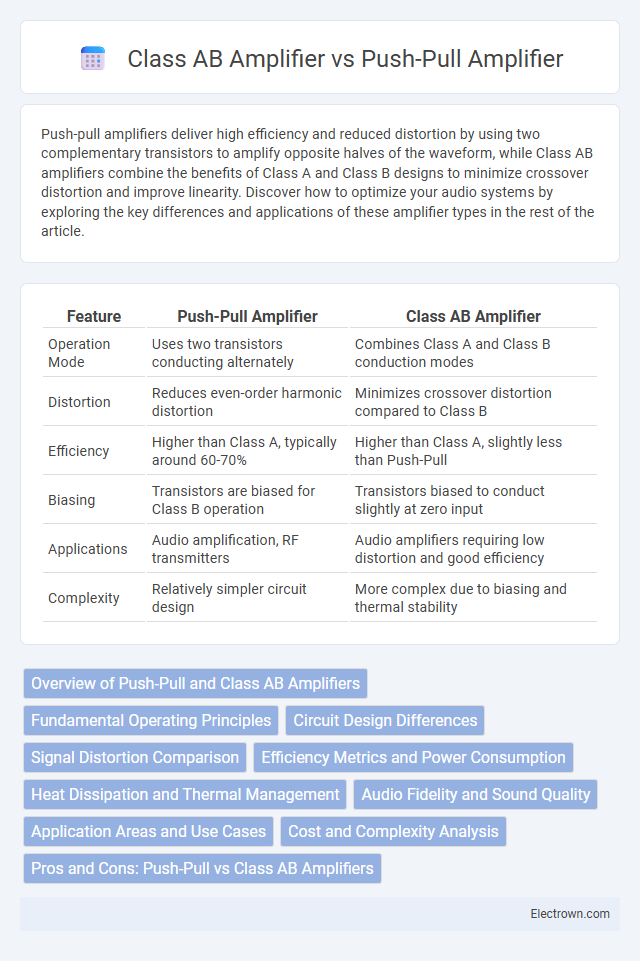Push-pull amplifiers deliver high efficiency and reduced distortion by using two complementary transistors to amplify opposite halves of the waveform, while Class AB amplifiers combine the benefits of Class A and Class B designs to minimize crossover distortion and improve linearity. Discover how to optimize your audio systems by exploring the key differences and applications of these amplifier types in the rest of the article.
Table of Comparison
| Feature | Push-Pull Amplifier | Class AB Amplifier |
|---|---|---|
| Operation Mode | Uses two transistors conducting alternately | Combines Class A and Class B conduction modes |
| Distortion | Reduces even-order harmonic distortion | Minimizes crossover distortion compared to Class B |
| Efficiency | Higher than Class A, typically around 60-70% | Higher than Class A, slightly less than Push-Pull |
| Biasing | Transistors are biased for Class B operation | Transistors biased to conduct slightly at zero input |
| Applications | Audio amplification, RF transmitters | Audio amplifiers requiring low distortion and good efficiency |
| Complexity | Relatively simpler circuit design | More complex due to biasing and thermal stability |
Overview of Push-Pull and Class AB Amplifiers
Push-pull amplifiers use two active devices that alternately amplify the positive and negative halves of the input signal, reducing even-order harmonic distortion and improving efficiency. Class AB amplifiers combine the low distortion of Class A operation with the efficiency of Class B by allowing both transistors to conduct during a small portion of the signal cycle, minimizing crossover distortion. These designs are widely used in audio applications for delivering high fidelity and power efficiency.
Fundamental Operating Principles
Push-pull amplifiers use two transistors or tubes operating in opposite phases to amplify both halves of an input signal, reducing distortion and improving efficiency. Class AB amplifiers combine the advantages of Class A and Class B designs by allowing both devices to conduct for slightly more than half the input cycle, minimizing crossover distortion. Understanding these fundamental operating principles helps you choose the right amplifier for balanced performance and sound fidelity.
Circuit Design Differences
Push-Pull amplifiers use two complementary transistors that alternately amplify positive and negative halves of the input signal, minimizing distortion and improving efficiency. Class AB amplifiers combine the low distortion of Class A with the high efficiency of Class B by biasing both transistors slightly on, reducing crossover distortion seen in simple push-pull designs. Your choice depends on the desired balance between linearity and power efficiency in the amplifier's circuit design.
Signal Distortion Comparison
Push-pull amplifiers typically exhibit lower even-harmonic distortion due to their symmetrical design, which cancels out even-order harmonics and improves linearity. Class AB amplifiers, while more efficient than Class A, may introduce crossover distortion near the zero-crossing point of the output waveform, affecting signal fidelity. Careful biasing in Class AB designs helps minimize this crossover distortion, making their signal distortion performance comparable to push-pull configurations in practical applications.
Efficiency Metrics and Power Consumption
Push-pull amplifiers exhibit higher efficiency by minimizing distortion through complementary transistor operation, achieving efficiency typically around 70-75%, which reduces power loss compared to traditional Class A stages. Class AB amplifiers balance linearity and efficiency, operating between 50-70% efficiency by combining Class A's low distortion with Class B's power-saving features, thereby lowering overall power consumption. Understanding these efficiency metrics helps you choose an amplifier that optimizes energy use while maintaining audio fidelity.
Heat Dissipation and Thermal Management
Push-pull amplifiers typically exhibit better heat dissipation due to their complementary transistor arrangement, which allows for efficient current sharing and reduced power loss. Class AB amplifiers combine the low distortion of Class A operation with the efficiency of Class B, resulting in moderate thermal management challenges that require proper heat sinks and ventilation. Optimal thermal design in both amplifier types involves selecting appropriate heat dissipation materials and maintaining adequate airflow to prevent thermal runaway and ensure reliable performance.
Audio Fidelity and Sound Quality
Push-Pull amplifiers reduce even-order harmonic distortion, providing a cleaner audio signal and improved sound clarity over single-ended designs. Class AB amplifiers combine the low distortion of Class A with higher efficiency, delivering balanced audio fidelity while minimizing crossover distortion. Your choice between the two impacts the overall sound quality, with Class AB often preferred in high-fidelity audio systems for its efficient, high-quality output.
Application Areas and Use Cases
Push-pull amplifiers excel in high-power audio amplification and RF transmission due to their efficiency and ability to reduce even-order harmonic distortion, making them ideal for professional sound systems and communication transmitters. Class AB amplifiers, combining the benefits of Class A and Class B designs, are widely used in consumer audio equipment, such as home stereo systems and guitar amplifiers, offering a balance of sound fidelity and power efficiency. Both amplifier types are crucial in different segments of audio and RF engineering, with push-pull designs favored for high-output scenarios and Class AB favored for moderate power applications requiring linear amplification.
Cost and Complexity Analysis
Push-pull amplifiers generally exhibit lower cost and reduced complexity due to their simpler design using complementary transistor pairs, which minimizes component count and manufacturing expenses. Class AB amplifiers, while slightly more complex because of their biasing networks to reduce crossover distortion, offer improved linearity at a moderate increase in cost and design intricacy. The trade-off between cost-efficiency and audio fidelity often guides the selection between push-pull and Class AB topologies in consumer and professional audio equipment.
Pros and Cons: Push-Pull vs Class AB Amplifiers
Push-pull amplifiers provide high efficiency and reduced distortion by using two devices to amplify both halves of the waveform, which minimizes even-order harmonic distortion but often results in crossover distortion challenges. Class AB amplifiers combine the advantages of Class A and Class B by operating devices slightly on during crossover, reducing distortion and improving linearity while maintaining better efficiency than pure Class A amplifiers. However, Class AB designs are more complex and can generate more heat than pure push-pull configurations, requiring careful biasing and thermal management.
Push-Pull Amplifier vs Class AB Amplifier Infographic

 electrown.com
electrown.com